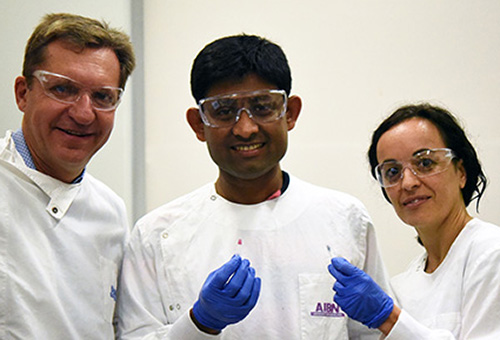Cancer researchers have long sought the Holy Grail of diagnostics—a single biomarker that can quickly detect cancer from blood or biopsied tissue. Now, researchers in Australia may have found that treasure. And the preliminary diagnostic test they have developed reportedly can return results in just 10 minutes with 90% accuracy.
In a news release, University of Queensland researchers discussed identifying a “simple signature” that was common to all forms of cancer, but which would stand out among healthy cells. This development will be of interest to both surgical pathologists and clinical laboratory managers. Many researchers looking for cancer markers in blood are using the term “liquid biopsies” to describe assays they hope to develop which would be less invasive than a tissue biopsy.
“This unique nano-scaled DNA signature appeared in every type of breast cancer we examined, and in other forms of cancer including prostate, colorectal, and lymphoma,” said Abu Sina, PhD, Postdoctoral Research Fellow at the Australian Institute for Bioengineering and Nanotechnology (AIBN), University of Queensland (UQ), in the news release.
“We designed a simple test using gold nanoparticles that instantly change color to determine if the three-dimensional nanostructures of cancer DNA are present,’ said Matt Trau, PhD, Professor of Chemistry at the University of Queensland, and Deputy Director and Co-Founder of UQ’s AIBN, in the news release.
The team’s test is preliminary, and more research is needed before it will be ready for Australia’s histopathology laboratories (anatomic pathology labs in the US). Still, UQ’s research is the latest example of how increased knowledge of DNA is making it possible for researchers to identify new biomarkers for cancer and other diseases.
“We certainly don’t know yet whether it’s the holy grail for all cancer diagnostics, but it looks really interesting as an incredibly simple universal marker of cancer, and as an accessible and inexpensive technology that doesn’t require complicated lab-based equipment like DNA sequencing,” Trau added.
Such a diagnostic test would be a boon to clinical laboratories and anatomic pathology groups involved in cancer diagnosis and the development of precision medicine treatments.
One Test, 90% Accuracy, Many Cancers
The UQ researchers published their study in the journal Nature Communications. In it, they noted that “Epigenetic reprogramming in cancer genomes creates a distinct methylation landscape encompassing clustered methylation at regulatory regions separated by large intergenic tracks of hypomethylated regions. This methylation landscape that we referred to as ‘Methylscape’ is displayed by most cancer types, thus may serve as a universal cancer biomarker.”
While methyl patterning is not new, the UQ researchers say they were the first to note the effects of methyl pattern in a particular solution—water. With the aid of transmission electron microscopy, the scientists saw DNA fragments in three-dimensional structures in the water. But they did not observe the signature in normal tissues in water.
“Methylation are marks that indicate whether pieces of DNA should be read,” Dino DiCarlo, PhD, Professor in the Department of Bioengineering and Biomedical Engineering, University of California Los Angeles (UCLA) and Director of Cancer Nanotechnology at UCLA’s Jonsson Comprehensive Cancer Center, told USA Today.

“To date, most research has focused on the biological consequences of DNA Methylscape changes, whereas its impact on DNA physicochemical properties remains unexplored,” UQ scientists Matt Trau, PhD (left), Abu Sina, PhD (center), and Laura Carrascosa (right), wrote in their study. “We exploit these Methylscape differences to develop simple, highly sensitive, and selective electrochemical or colorimetric one-step assays for the detection of cancer.” (Photo copyright: University of Queensland.)
Their test averaged 90% accuracy during the testing of 200 human cancer samples. Furthermore, the researchers found the DNA structure to be the same in breast, prostate, and bowel cancers, as well as lymphomas, noted The Conversation.
“We find that DNA polymeric behavior is strongly affected by differential patterning of methylcytosine leading to fundamental differences in DNA solvation and DNA-gold affinity between cancerous and normal genomes,” the researchers wrote in NatureCommunications.“We exploit these methylscape differences to develop simple, highly sensitive, and selective electrochemical or one-step assays for detection of cancer.”
Next Steps for the “Gold Test”
“This approach represents an exciting step forward in detecting tumor DNA in blood samples and opens up the possibility of a generalized blood-based test to detect cancer, Ged Brady, PhD, Cancer Research UK Manchester Institute, told The Oxford Scientist. “Further clinical studies are required to evaluate the full clinic potential of the method.”
Researchers said the next step is a larger clinical study to explore just how fast cancer can be detected. They expressed interest in finding different cancers in body fluids and at various stages. Another opportunity they envision is to use the cancer assay with a mobile device.
DiCarlo told USA Today that such a mobile test could be helpful to clinicians needing fast answers for people in rural areas. However, he’s also concerned about false positives. “You don’t expect all tumors to have the same methylation pattern because there’s so many different ways that cancer can develop,” he told USA Today. “There are some pieces that don’t exactly align logically.”
The UQ researchers have produced an intriguing study that differs from other liquid biopsy papers covered by Dark Daily. While their test may need to be used in combination with other diagnostic tests—MRI, mammography, etc.—it has the potential to one day be used by clinical laboratories to quickly reveal diverse types of cancers.
—Donna Marie Pocius
Related Information:
Nano-Signature Discovery Could Revolutionize Cancer Diagnosis
One Test to Diagnose Them All: Researchers Exploit Cancers’ Unique DNA Signature
Cancer Researchers in Australia Develop Universal Blood Test



